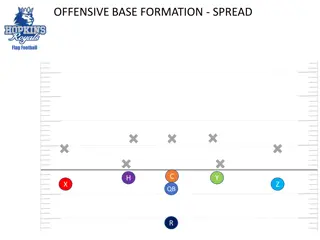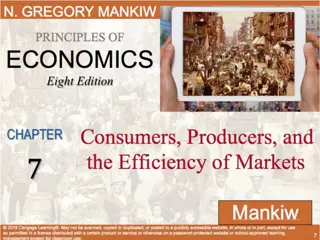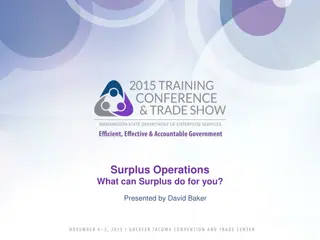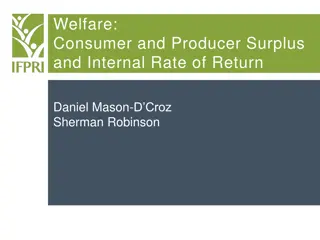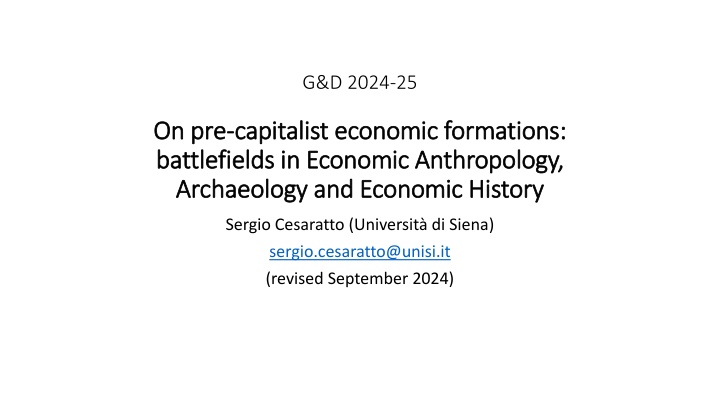
Surplus Approach in Economic Anthropology and History
Explore the significance of surplus in economic formations through the lens of Economic Anthropology, Archaeology, and Economic History. Delve into the core concepts of surplus, social product, and historical analysis, shedding light on how surplus is central to institutional frameworks.
Download Presentation

Please find below an Image/Link to download the presentation.
The content on the website is provided AS IS for your information and personal use only. It may not be sold, licensed, or shared on other websites without obtaining consent from the author. If you encounter any issues during the download, it is possible that the publisher has removed the file from their server.
You are allowed to download the files provided on this website for personal or commercial use, subject to the condition that they are used lawfully. All files are the property of their respective owners.
The content on the website is provided AS IS for your information and personal use only. It may not be sold, licensed, or shared on other websites without obtaining consent from the author.
E N D
Presentation Transcript
G&D 2024-25 On pre On pre- -capitalist economic formations: capitalist economic formations: battlefields in Economic Anthropology, battlefields in Economic Anthropology, Archaeology and Economic History Archaeology and Economic History Sergio Cesaratto (Universit di Siena) sergio.cesaratto@unisi.it (revised September 2024)
Inspirations Inspirations Our original source of inspiration was Jared Diamond's Guns, Germs, and Steel: the rise of a surplus in some parts of the world allows for the appearance of 'civilisation' (a section of the population freed from subsistence production that can engage in superior' activities). The language used by Diamond surplus, subsistence, productive and unproductive labour the same we find used by classical economists. Diamond does not cite any economist, classical or marginalist. This demonstrates how little use modern economics was to him. At the same time, however, we can presume that Diamond was hardly exposed to the ideas of classical economists like Anne-Robert-Jacques Turgot (1727 1781) and Adam Smith (1723 1790) who advanced theories that anticipated that of Arms, steel and germs on the basis of the first reports from the new lands just then discovered. This stimulated curiosity as to whether in anthropology, archaeology, history of ancient societies the use of the concept of surplus, submerged and forgotten (Sraffa) as a result of the marginalist revolution, was wider. As a result of this exploration, not only have we discovered that this use is very broad, but that the concept of surplus is central to a heterodox approach to pre/capitalist economic formations and the institutions that regulate them. Surplus and institutions form an inseparable nexus. This also vindicates Sraffa's classical approach as an open system. In this presentation we will provide an overview of our work and the complex problems we still face
The surplus approach The surplus approach The surplus approach is encapsulated in the formula: P N = S where S is that part of the physical net social product P (net of reproduction of the means of production) which is left once workers necessary consumption , N, is paid. The social surplus S can be defined as the part of the social product P left, once society has put aside what is necessary N to reproduce the social output at least at the current level, and that can thus safely be used for any other purpose. We believe that this formula is applicable to all social formations we study, as the 'core' of institutional historical analysis. The surplus approach is by definition an 'open system'. At the heart of the surplus approach is the idea that civilization , as we understand it, presupposes the existence of a surplus, i.e. that only part of the population is needed to ensure subsistence, and that the remainder can engage in superior activities.
The core of classical analysis for capitalist economies The core of classical analysis for capitalist economies Three circumstances are taken as given when approaching the determination of the social surplus: a) the level and composition of output, b) the technical conditions of production, and c) the real wage. The analysis of the three categories of data is deferred to a different, further stage of the investigation. Combining these data as in figure 1 the shares other than wages (surplus) can be determined (Garegnani 1984, p. 293): (a) Social product (b) Technical conditions Labour employment Profits (c) Real wage Necessary consumption inner relations (black arrows): circumstances (a) and (b) determine labour employment that, along with (c), regulates necessary consumption; surplus profits are finally determined on the basis of equation (2). The data (a), (b) and (c) are investigated out-of-the-core. Source: Garegnani 2018, p. 622.
From capitalism back to pre From capitalism back to pre- -capitalism capitalism Sraffa and Garegnani (as well as Marx and Ricardo) applied this analytical scheme to capitalism. But the classical tradition (and also Marx) suggested the notion of surplus as the analytical key to understanding social-economic history. It is a long tradition still present (often mediated by Marxism) in the disciplines of anthropology, archaeology, and ancient and medieval history. To anticipate my thesis: the surplus approach is the study of income distribution under different, historically given economic formations, each characterized by different institutional mechanism that preside over the production and distribution of the social output and eventual surplus. One difference between capitalism and pre-capitalist formations is that in the former the production and distribution of the surplus is regulated by market exchange and competition (so we have formal relations in the core ) while in pre-capitalism the production and distribution of the surplus is regulated by personal-political-institutional relations. This point was made by Marx and later by Karl Polanyi.
Classical economists and Marx Classical economists and Marx The idea of different economic formations characterizes the surplus approach since its sunrise in the XVIIIth century. The idea of stages of economic development was suggested by the geographical discoveries and contact with primitive societies (primitive hasn t any depreciative meaning). Note that a moral debate on the social nature of those formations was initiated by J.J. Rousseau (the good savage ), or by Hobbes (homo homini lupus) According to pre-classical authors, Meek (1976) argues, societies undergo development through successive stages based on different modes of subsistence . Four stages emerged as prevalent, as also finally ratified by Smith (already in the Lectures on Jurisprudence in the early 1760s): hunting, pasturage, agriculture and commerce. Based as they were on inference from the early reports from the newly discovered lands, in particular from the Americas this classification does not disfigure in view of modern research. A very materialist interpretation of history: social organization changes with its material foundations. Marx is of course the central and most complex author. In Marx the theory of stages becomes an analysis of economic formations defined as economic-institutional complexes (the broad classification is known: ancient/slavery, feudal, capitalist, but also Asian and Germanic formations). To Marx (and Engels) we owe the distinction between the regulation of social relations based on market rules (capitalism) or on personal relations (pre-capitalist formations). Marx s influence on Karl Polanyi is evident. Marx's writings on pre-capitalist formations, however, are only sketches, and we are still left with great uncertainty about the definition of economic formations and the associated laws of change.
Marx on pre Marx on pre- -capitalist formations capitalist formations Marx was obviously interested in showing that capitalism was a particular and historically determined economic formation. Of immense culture, Marx was very interested in the early anthropological studies conducted by Lewis Henry Morgan (1818-1881) with a materialist approach. In the simplest version of historical materialism, an economic formation comprises a structure (mode of production) and a superstructure (institutions, culture). The mode of production concerns the relationship between labour and the means of production. In the most schematic version, for example, - hunter-gatherers (primitive communism): absence of ownership of the means of production and output; - slavery: both labour and means of production, and output privately owned - serfdom: semi-free labour retaining ownership of the means of production (partially of land), but having to share output or labour as services on the landlord s land. - capitalism: free labour, private ownership of the means of production and output. - Asian mode of production (?): free labour controlling the means of production, but storage of the product at the palace (Palatial system) and redistribution (Mesopotamia?)
Mechanical Marxism Mechanical Marxism Mechanical version of Marx s theory (Althusser): Rigid classification of economic formation in which one mode of exploitation (slavery, serfdom and wage-labour) defines a social formation Change in the structure (technical change or class struggle) change in the superstructure We do not have a definite view from Marx, who is in any case very flexible (modes of production overlap and coexist, perhaps with one dominating, he has very nuanced historical views .). There is a vast and complex Marxist debate on these themes. I have not reached definite results. There are important hints in Marx. He characterized all pre-capitalist formation, mainly agricultural, as based on rent (or taxation) extracted on land in various forms - not only using combinations of slavery or serfdom or wage-labour but also of the exploiters (central redistributive state, decentralised feudalism, mix of private and public property etc) Be this as it may, the surplus approach has been widely applied in economic anthropology, archaeology and history of pre-capitalism.
Surplus and institutions in economic anthropology and archaeology Surplus and institutions in economic anthropology and archaeology Economic anthropology: the concept of surplus is widely adopted in economic anthropology from Melville Jean Herskovits (1895-1963), the author of the first manual in economic anthropology (object of ferocious criticism by Frank Knight), to Jared Diamond and many present anthropologists. Anthropologists are particularly interested in the origin of surplus and stratification: why and how did we move from relatively affluent hunter-gatherers societies to agriculture, and how did stratification emerge? Marshall Sahlins is obviously the path breaking author in this tradition. Archaeology: Vere Gordon Childe (1892-1957), the greatest archaeologist of the last century (Marxist, communist and eccentric), permeated our way of thinking about the transition between prehistory and history in which the emergence of a surplus played a key role (he coined the terms Neolithic revolution--> transition from hunter-gatherers societies to agriculture; and urban revolution --> the emergence and appropriation of a surplus and the birth of cities) The use of the term 'surplus' is widespread in archaeology. We are in touch with Marcella Frangipane (La Sapienza and member of the Am.Ac.of Sc.) who is quite interested on how stratification emerged in Mesopotamia. The theme is recurring: how do institutions emerge that transform a potential surplus into an actual, elite-controlled surplus?
Surplus and institutions in economic history Surplus and institutions in economic history History of Ancient Civilizations: the concept of surplus is clearly adopted by Marxists like the British historian Perry Anderson (1974) (famous and worth reading); and Geoffrey Ernest Maurice de Ste. Croix (another great Oxford Marxist historian), but also by non- Marxists. de Ste. Croix asked the correct question: How, otherwise, did that class ( ) derive its surplus? (his answer regarding the Greek-Roman civilization was: from slavery, although a minor share of the labour force). Great controversies have taken place in economic anthropology, archaeology and economic history between the Polanyian tradition (Substantivism or Primitivism) and the tradition influenced by neoclassical economists (Formalism or Modernism) Is the difference between capitalism and pre-capitalism of kind (Polanyians) or of degree (marginalists)? In my view Polanyi has taken almost all from Marx (edulcorating it) We argue that the classical surplus approach is a third way (although closer to Substantivism and Primitivism: difference in kind).
Substantivists Substantivists (anthrop.) Karl Polanyi (anthropologist 1886-1964) argued that in primitive or ancient economies the economy is not a sphere separate from interpersonal relations, it is 'embedded'; only in capitalism through the market does the economy becomes disembedded. Rejection of homo economicus. Rediscovery of the economics of gift and reciprocity (Malinowski, Mauss). See Marchionatti e Cedrini (2017) for a modern reappraisal. Moses Finley (Cambridge historian 1912-1986) argued that in the Greek-Roman economies extra-economic moral values and political institutions prevailed over economic interests, an echo of Karl Polanyi s thesis that, before capitalism, the economy did not constitute an autonomous social sphere. Markets might be marginal (as in the antiquity) but an economic structure still exists based on the historically given modes of extraction of the social surplus. Notably, both Polanyi and Finley identified the economic sphere with the market, and eventually the economic discipline with marginalism, appliable therefore to market economies only. The last point might be true to some extent (in fact NIE intends to explain economic institutions in non-market economies, at least as market failures ). The surplus approach is anyway appliable to all formations. (anthrop.) Primitivists Primitivists ( (ec. ec. History), difference in kind History), difference in kind
Substantivists Substantivists versus Formalists and versus Formalists and Primitivists Primitivists versus Modernists versus Modernists Adam Smith is often regarded as the forerunner of homo economicus (natural disposition to trade), so progress is a progress towards a market economy. Late XIXth century, early debate among German historians at the time of the controversy over method (between the German historical school and Menger). The debate between M. J. Herskovits and Frank Knight followed in the 1940s. 1960s: debate between Polanyi (1960s)&Finley (1980s) and marginalist economists who regarded mainstream economics as useful for interpreting primitive and ancient economies (differences in degree not in kind) 1980s: ancient societies were market societies, but information asymmetries were an obstacle to the full development of markets. This lays the groundwork for explaining the institutions of ancient societies. Institutions as social devices to reduce transaction costs (NIE). NIE or rather transaction cost economics can be a useful theory for industrial economics and the applied economist, but certainly a poor explanation of political institutions. In the classical surplus approach, structure (economics) and superstructure (institutions) are symbiotic.
New Institutional Economics I New Institutional Economics I Origins: transaction costs (TC) economics (Coase). Institutions exist to solve market failures. Coase: firms exist to meet transaction costs: within the firm transaction are regulated by management and organization not by market; the latter may be inefficient especially because of asymmetric information that might generate lack of trust between the traders; or you not want to depend on an external technology etc. In my view NIE interesting for industrial economics (Oliver Williamson), not for economic history (Douglas North)
New Institutional Economics II New Institutional Economics II Douglass North more ambitious. When young he was a Marxist (when fashionable of course). He understood that Marx had a complete theory of economy and institutions (I do not believe is so complete, but compared to the misery of mainstream economics!) He abandoned the initial TC approach (institutions as an efficient solution to TC). He tried various directions which are difficult to sum up. (History conditioned by ideologies and beliefs, exploitative governments (later Acemoglu and Robinson) etc.). He always kept a liberal/Walrasian society as the final aspiration of history (this is parallel to bad Marxism which sees socialism as the inevitable result of history). Interested students may look at Cesaratto (2024)
A third way A third way We argue that the classical surplus approach revived by Piero Sraffa is a third way: an economic approach in which the economic sphere does not coincide with exchange. Moreover, the surplus approach is intimately linked to the analysis of institutions, understood as the social forms in which the production and distribution of surplus is ordered. Cambridge (now Oxford) historian Sheilagh Ogilvie, in her criticism of NIE, also pointed out that institutions exists in order to regulate social conflict over income distribution. This is a promising foundation of an heterodox economic theory of institutions in which neither the institutions nor the concept of surplus are, respectively, hanging on themselves. This also vindicates the open system nature of Sraffa s surplus approach (Davis 2017), Sraffa s anthropological way , as Wittgenstein put it. We met, however, a Polanyian criticism of the surplus approach.
Sraffa did not go unnoticed Sraffa did not go unnoticed Let us first note that the revival of the surplus approach by Sraffa and Garegnani did not go unnoticed by anthro/archeologists and historians, for example Sraffa (and Joan Robinson) were quoted by De Ste. Croix. A well-known Australian anthropologist, Chris Gregory, wrote his thesis supervised by the Cambridge Sraffian economist Murrey Milgate. Anthropologist Stephen Gudeman (1978) argued that: In sum, Sraffa presents anthropologists with that which they lack a way of conceptualizing and calculating production and distribution but that which they may accept only upon condition of placing it within a set of historically and culturally determined social relationships. To paraphrase the philosopher, this is a method in search of a society . On a similar vein, Clark (1992) maintained that most Sraffians will mention the importance of historical and institutional factors, yet these factors are given no active role , and that [a]ny concept of economic order must be placed in the larger issue of social order, and this order is more than a market equilibrium. In fact, it is the social order that creates the economic institutions . But let us turn to the Polanyian criticism to the concept of surplus.
The The Polanyian Polanyian criticism of the concept of social surplus I criticism of the concept of social surplus I To begin with, we reject the Polanyian thesis that marginalism is fine when applied to market economies, while it is wrong when applied to pre-capitalist formations, in which economic relations were relatively less important (a similar stance was also held by prominent historian of ancient Greece, Moses Finley). We reject the Polanyian thesis for two reasons: Marginalism is wrong also when applied to capitalism, and the economic discipline should not be identified with marginalism; Economic relations were important also in pre-capitalist societies. As Marx ironically commented: This much, however, is clear, that the middle ages could not live on Catholicism, nor the ancient world on politics. On the contrary, it is the mode in which they gained a livelihood that explains why here politics, and there Catholicism, played the chief part. Don Quixote long ago paid the penalty for wrongly imagining that knight errantry [an historically given institution] was compatible with all economic forms of society. (Capital vol I) Simplifying, one thing is to say that in pre-capitalistic formations personal relations matter more than (or as much as) market-mediated relations (Marx); another is to conclude that, therefore, economic analysis of ancient formations is irrelevant (Polanyi, Finley); and anyway economics does not coincide with markets.
The The Polanyian Polanyian criticism of the concept of social surplus II criticism of the concept of social surplus II Polanyians, however, put forward a criticism of mechanical uses of the concept of surplus that we accept: the concept of surplus is useful only where the conditions of a specific surplus are institutionally defined (Pearson 1957) since [t]here are always and everywhere potential surpluses available. What counts is the institutional means for bringing them to life (ibid., p. 339). A similar stance we have found in other scholars: Anthrologist Morehart (2014) argues that studying surplus is incomplete without considering the historical and subjective [in a social sense] aspects of surplus as it is connected to differing and overlapping institutional spheres . Institutionalist Adams (1991) has argued that relative surpluses appear simultaneously with the enabling institutions rules, procedures, and sortings that achieve their realization and distribution . We agree with these arguments that it does not make sense to talk of surplus in general as a generic abstraction , but only as a determined abstraction (Marx) fully immersed in the historical institutional circumstances that regulate its production and distribution.
Storage and social stratification Storage and social stratification Polanyi s criticism must be welcomed. The origin of the institutional mechanism that transformed technical opportunities (potential surpluses) in new social relations of production and distribution is as much important (or even more important) than technology per se. There are crucial issues to be studied in this area, and they have to do with the origin of inequality: H-G egalitarianism is a 'natural' factor (Rousseau) or an institutional/artificial mechanism (suppression of emerging/dominant figures); how did ancient populations move from potential agricultural surplus to its appropriation by an elite? In Neolithic societies with the agricultural revolution, storage became systematic and massive, and control of the warehouses by an lite constituted the key step for stratification (see Frangipane 2019). Since harvests are typically periodic, the very possibility of storing the product for seeding and deferred consumption is a prerequisite of agriculture. Storage also makes it possible to set aside some surplus over normal replacement requirements and subsistence in anticipation of unfortunate future events, such as famines, floods, etc. These surpluses are referred to in the literature as "normal surpluses. Storage in turn implies its social management and defence against potential enemies. Normal surpluses may thus constitute an intermediate step towards stratification. The management of warehouses and "normal surpluses" may provide priests or personalities who impersonate the fortunes of the community with the occasion to transform themselves into the dominant lite.
How inequality was born? How inequality was born? In other words, there are (were) hunter-gatherer societies that have a potential surplus, but deliberately do not exploit it, they dissipate it, or destroy it. They have open strategies to avoid the appropriation of the surplus and social stratification Of course, it is with agriculture that the surplus emerges in a systematic way, but again, the exploitation of this potential is not automatic, historical processes must be identified through which, in particular, elites have appropriated the surplus. Moreover, the very adoption of agriculture does not appear to have been beneficial to many H-G populations: they fared better as H-Gs in terms of diet, labour effort and (fairly egalitarian) social relations compared to peasants (here Marshall Sahlins' contribution is crucial). The early human choices have been fundamental. Lively debates on the social, biological and socio-biological determinants of these choices. If you want to discuss inequality, these are your fields: biology and history (and a touch of surplus approach). Much debated ahs recently been David Graeber and David Wengrow, The Dawn of Everything
Our troubles and the way ahead Our troubles and the way ahead I believe that our approach to understand ancient institutions and societies is sound: institutions do exist in order to regulate the extraction and distribution of the social surplus. How institutions and the complex material base of the economy co-exist and co-evolve is an open question. In the meantime, we believe that an effort to communicate with anthropologists, archaeologists and historians who use the concept of surplus is essential: only they can help us understand how the classical surplus approach can be applied to pre-capitalist formations, and symmetrically we may help them to use in a rigorous way the approach. For now we are satisfied that what prompted us to undertake this investigation has been proven, that is, we had our cake (the concept of surplus) and we also ate it (it is fruitfully used in the historical-social sciences). I AM VERY INTERESTED IN SUPERVISING THESES ON THESE TOPICS
References References Cesaratto S. (2019) Heterodox Economics and Economic Anthropology: Reflections Prompted by Two Books, Quaderni DEPS no. 807. Cesaratto, S. (2023) Schools of Athens: surplus approach, Marxism and institutions, WP-Centro Sraffa n. 62. Cesaratto, S. (2024a). Agency, functionalism, and all that. A Sraffian view. , Journal of Philosophical Economics, Volume XVII (Annual issue), 48-84 Cesaratto, S. (2024b) Three approaches to institutions in economic analysis: Polanyi, North and the surplus approach s third way, Economia Politica, 41, 267-293. Cesaratto, S. (2024c) Surplus approach and institutions: where Sraffa meets Polanyi, Journal of Economic Issues, LVIII No. 3 (Sept.), 989-1011. (working paper version WP-Centro Sraffa n. 61). Cesaratto, S. and Di Bucchianico, S. (2021a) The surplus approach, Polanyi and institutions in economic anthropology and archaeology, Annals of the Fondazione Luigi Einaudi, 55 (1), pp. 185-216 (special issue Marshall Sahlins s Stone Age Economics, a Semicentenary Estimate ). Cesaratto, S., and Di Bucchianico, S. (2021b) The Surplus Approach, Institutions, And Economic Formations, Contributions to Political Economy, 40 (1), pp. 26 52.






